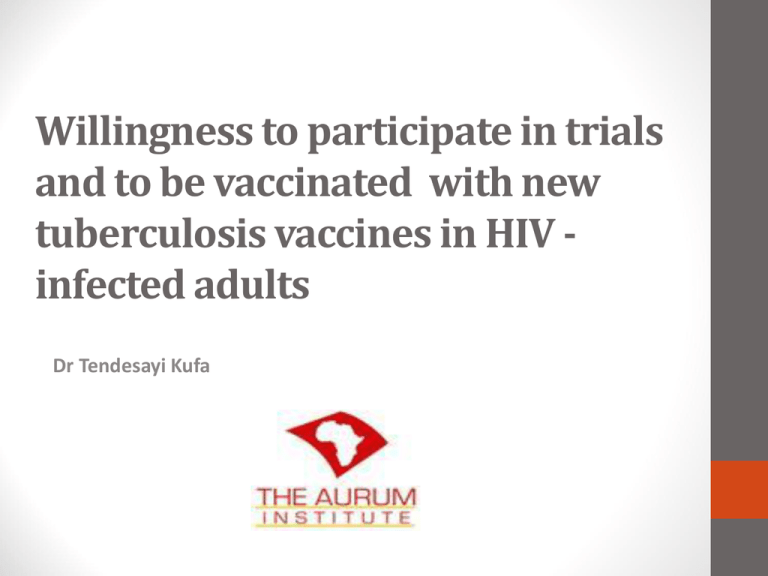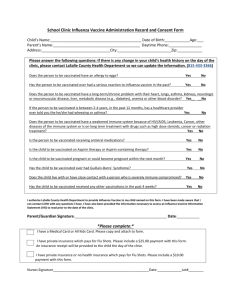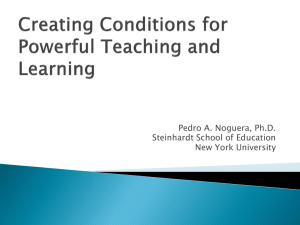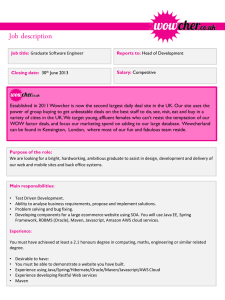Willingness to participate in trials of and acceptability of new..
advertisement

Willingness to participate in trials and to be vaccinated with new tuberculosis vaccines in HIV infected adults Dr Tendesayi Kufa Background • New TB vaccines are needed to meet global targets for TB control • HIV-infected individuals are an important target population for new vaccines • At least three vaccine candidates in phase I/II trials involving people with HIV • Phase III trials will require large numbers of participants • Little data on willingness to participate in TB vaccine trials and to be vaccinated with newly licenced vaccine Objectives • Describe willingness to participate in TB vaccine trials among HIV-infected in care • Describe willingness to be vaccinated with newly licenced TB vaccine • Determine factors associated with the willingness Methods- design and setting • Design • Cross-sectional design • Context • Vaccine preparedness study to estimate TB incidence in HIV+ with high CD4 counts • Setting • 2 primary care clinics in Ekurhuleni North sub-district Gauteng Methods – eligibility criteria • Inclusion criteria • • • • • Known HIV positive CD4 counts >300 cells/µl in preceding 12 months Living or working in catchment area of clinic 18 years or older Willing and able to give consent • Exclusion • Acutely ill • Pregnant (enrolled but not followed up) Methods- study procedures • Patients invited to take part at point of registration for HIV care • Questionnaires with questions on demographics, TB and HIV history, TB knowledge and perception of risk administered • One questionnaire contained two Likert type scales with 5 and 6 items respectively to measure willingness Methods – measurement scales • Items in scales selected based on factors identified as barriers/facilitators to willingness • for each item, responses were scored: 5=“strongly agree”, 4=“agree”, 3= “disagree” 2= “strongly disagree” 1= “I don’t know” • Item scores were summed to give overall score on each scale • Internal consistency reliability determined during analysis by determining values of Cronbach α • α > 0.70 considered acceptable Willingness to participate scale, α=0.92 I would be willing to : • take part in studies to test if a new injection to prevent TB works or not • let my family members take part in studies to test if a new injection to prevent TB works or not • let my children take part in studies to test if a new injection to prevent TB works or not • let my children take part in studies to test a new injection to prevent TB if I was convinced it would work • let my children take part in studies to test a new injection to prevent TB even if it was painful • let my children take part in studies to test a new injection to prevent TB even if it made me a little sick (like vomiting, rashes, fever) Willingness to be vaccinated scale, α=0.69 Once a new injection to prevent TB has been shown to work in studies, I would be willing to get it: • If it became available at my clinic • For my family or household members if it became available at my clinic • For my children if it became available at my clinic • Even if it made me a little sick (like vomiting, rashes, fever) • Even if I had to pay for it Outcomes and statistical analysis • Outcomes • Willingness to participate in a trial of new TB vaccine (defined as scored ≥24 out of possible score of 30) • Willingness to be vaccinated with new TB vaccine (defined as scores ≥ 20 out of possible score of 25) • Data analysis • Descriptive statistics used to describe the population • Univariable and multivariable binomial regression was used to estimate prevalence ratios (PR)associated with outcomes Findings Study summary 2191 screened 1352 (61.7%) Ineligible (96% because of low CD4 counts ) 839 (38.3%) enrolled 12 (1.4%) Duplicate enrolments / missing data 827 (98.6%) analysed 771 (93.2%) responded to all 6 items on WTP scale 765 (92.5%) responded to all 5 items on WTV scale Study population Variable Total N=827 Age (years) , median (IQR) 35 (29- 42) Female , n (%) 665 (80.4) Employed , n (%) 326 (39.4) Previous TB , n (%) 227 (27.5) Reporting ≥1 TB symptoms , n (%) 215 (26) On ART at enrolment , n (%) 597 (72.1) Prior or current IPT use, n (%) 189 (22.6) Current CTX use , n (%) 116 (14) CD4 count (cells/µl), median (IQR) 523 (427- 659) BMI (kg/m2), median (IQR) 24.1 (21.1- 27.8) Identified all 4 TB symptoms, n (%) 442 (53.5) Identified TB/HIV association, n (%) 704 (85.1) Considered one-self at risk , n (%) 442 (53.5) Willingness to participate in trials • Overall WTP was 84.5% • 63% responded “strongly agree” to all items in the scale • Associated with: • Correctly identifying TB symptoms [aPR 1.10 (1.03- 1.17), p=0.003]* • Considering oneself at risk of TB [aPR 1.07 (1.01- 1.13), p=0.024]* *model adjusted for age, previous TB, IPT use, CPT use, knowledge of symptoms, knowledge of TB/HIV association and perception of risk Willingness to be vaccinated • Overall willingness to be vaccinated was 92.6% • 59% responded “strongly agree” to all items in the scale • Associated with: • Being employed [aPR 1.04 (95% CI 1.01- 1.08), p=0.014]* • Considering oneself at risk of TB [aPR 1.05 (95% CI 1.011.09), p=0.02]* *model adjusted for employment, knowledge of symptoms, knowledge of TB/HIV association and perception of risk Limitations • Hypothetical willingness does not translate to actual participation • Scales not previously validated • Likert scales • Social desirability • Uniform scale intervals Conclusions • WTP and willingness to be vaccinated were high in this population • Associated with knowledge of TB, perception of risk and employment • Education to improve knowledge of TB and risk factors may increase WTP/ willingness to be vaccinated Acknowledgements • Staff and patients • Aurum • Violet Chihota, Salome Charalambous, Gavin Churchyard • Study team- Sarah Yates, Joseph Makhura , Marcia Masevhe, Jessie Witkoei, Salome Mahlangu, Lebogang Masia. • KNCV • Suzanne Verver, Ellen Mitchell • Funders • EDCTP








